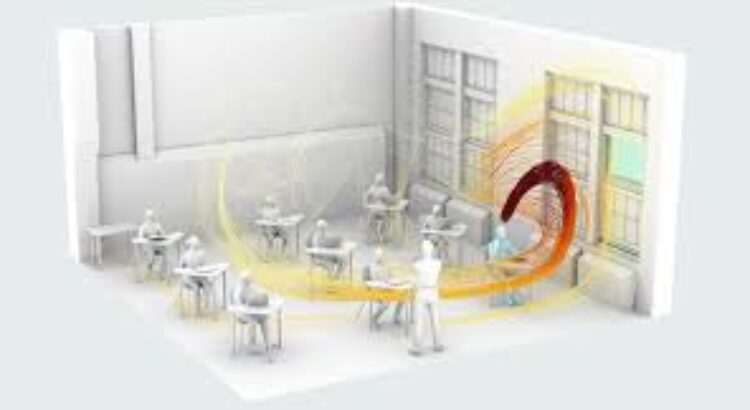Why Opening Windows Is a Key to Reopening Schools
The C.D.C. is urging communities to reopen schools as quickly as possible, but parents and teachers have raised questions about the quality of ventilation available in public school classrooms to protect against the coronavirus.
We worked with a leading engineering firm and experts specializing in buildings systems to better understand the simple steps schools can take to reduce exposure in the classroom.
Here’s a typical classroom from the pre-Covid era with about 30 students. This scene is based on a real public school classroom in New York City.
New York City put strict protocols in place for reopening schools, and in-school transmission of the virus has been very low. Students must practice social distancing and wear masks, and classrooms must have windows that open.
This classroom seats just nine students, all wearing typical cloth face masks, facing forward and sitting six feet apart. With all of the windows closed, the room would lack sufficient ventilation. That’s a problem with an airborne virus.
The students are wearing masks, but their breath still circulates and mixes around the room. About 3 percent of the air each person in this room breathes was exhaled by other people.
Even students who look healthy may be asymptomatic carriers who can transmit the virus. Let’s see what happens when we introduce an infected student to the mix.
These lines trace the student’s warm breath as it rises and begins to disperse contaminated respiratory aerosols throughout the room. The contaminants are most concentrated where the lines are darkest.
While we still do not know exactly what level of contamination presents the greatest risk of infection, “exposure is a function of concentration and time,” said Joseph G. Allen, the director of the Harvard Healthy Buildings program and an environmental health expert.
Within a short time, the room approaches its peak level of contamination. With little fresh air coming into the space, the contaminants continue to circulate throughout the room.
Experts agree that good ventilation is the most effective and practical way to rid a space of contaminants. The Healthy Buildings program recommends four to six air exchanges per hour in classrooms, through any combination of ventilation and filtration.
New York City mandated every classroom have at least one operable window to help with ventilation, even in the winter. So let’s see what happens when we open a window.
The fresh air dilutes the contaminants as they move around the room. “Simple and inexpensive measures can make schools much safer,” said Scott E. Frank, whose engineering firm JB&B assisted with these simulations
We managed to achieve four total air exchanges by opening just one window in this simulation, which was dependent on specific weather conditions. To get to six air exchanges, we will have to do more.
Let’s try adding a simple air cleaner with a HEPA filter and a box fan blowing fresh air into the room, both practical and low-cost options.
The increased fresh air blowing into the room and the filtered air coming from the air cleaner help to further dilute the contaminants as they spread in the space.
Airflow is one way to understand the importance of ventilation, but we can also look at the data another way.
Here’s a view of the same classroom with the window closed again. Each layer shows a full cross-section of the space once the room has reached a peak level of contamination.
With the window closed, the contaminants accumulate in high concentrations because they have nowhere to go.
The concentration is highest where the warm air rises, but contaminants are also spreading at the level where the students are breathing.
The dense reddish fog shows a high concentration of contaminants spreading far beyond six feet from the infected student. If the student were sitting elsewhere, the pattern would be different but the buildup in the room would be similar.
With the window open, the concentration remains densest near the infected student, but the contaminants are diluted in the rest of the room. Exposure for the other students is reduced.
And with an air cleaner and a fan, the overall concentration levels are at their lowest. The contaminants are concentrated at the front of the room where the fan is blowing, and diluted everywhere else.
Though we achieved six air exchanges with these measures, there are ways we could further improve ventilation in this space.
The Healthy Buildings guidelines call for a fan blowing out the window, not in. “We don’t want to ever blow air across anyone’s face, not knowing who’s infected,” Dr. Allen said.
And since our open window and fan were in the front of the room, we placed our air cleaner in the back for balance. When you don’t know the airflow patterns, it’s generally best to put it in the center of the room.
These simulations offer examples based on specific inputs, but they show how ventilation and filtration can work alongside other precautions like masking and social distancing.
“Improving ventilation is only one part,” said Mark Thaler, who is an expert in school spaces with the design firm Gensler. “It has to stand with all the other C.D.C. guidelines in order to really safely reopen.”
Fuente de la Información: https://www.nytimes.com/interactive/2021/02/26/science/reopen-schools-safety-ventilation.html







 Users Today : 176
Users Today : 176 Total Users : 35402725
Total Users : 35402725 Views Today : 234
Views Today : 234 Total views : 3331854
Total views : 3331854